How to root prune cannabis
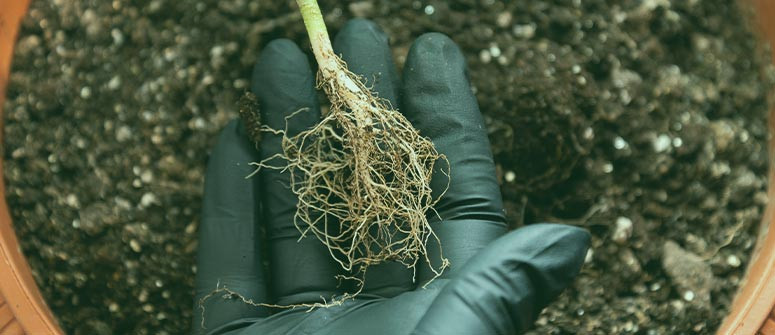
While it might seem counterintuitive to cut away at a plant's roots, root pruning can help to treat root-bound cannabis plants and encourage a more robust root system, resulting in healthier growth above the ground. Keep reading to learn how to root prune your cannabis plants.
Contents:
Root pruning involves trimming a plant's roots—either manually or by air pruning (which happens naturally in smart or fabric pots). Helping to prevent and combat bound roots, which can seriously stunt plant growth, as well as improving water and nutrient uptake, root pruning is an essential skill for any cannabis grower. Keep reading to learn how to root prune your cannabis and grow thriving plants with great yields.
What is root pruning cannabis, and why should you do it?
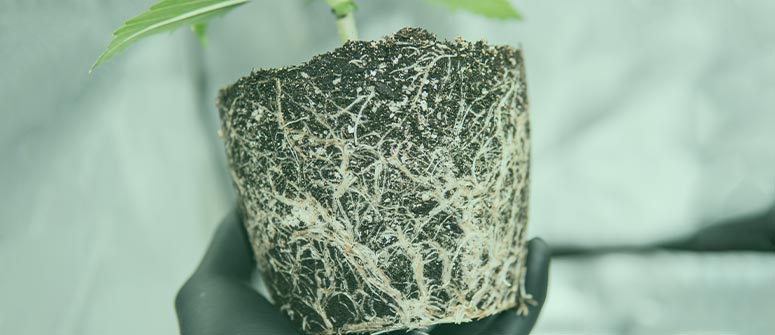
As the name suggests, root pruning involves cutting back a plant’s roots. And while it might seem counterintuitive to take a pair of pruning scissors to a plant’s root system, root pruning can actually be very beneficial for cannabis plants. And it works in both soil and soilless/hydro grows.
As cannabis plants grow, their roots spread out in search of water and nutrients. As they encounter obstacles (such as the edge of pots), roots might shoot off in other directions. Over time, this can cause the roots to become bound, resulting in less nutrient and water uptake. If left unaddressed, root-bound plants can become stunted.
The aim of root pruning is to prevent plants from becoming root-bound while simultaneously promoting healthy root growth. Root pruning can also help to control a plant’s size and growth, which can be beneficial for growers working with limited space.
Will root-bound cannabis plants die?
Yes—potentially. If plants are left root-bound for extended periods of time, they can die. When the roots become bound, they stop growing. Over time, root-bound plants may struggle to properly take up nutrients and water, which can lead to stunted growth, wilting foliage, and, in extreme cases, the death of an entire plant.
Will cannabis roots grow back after pruning?
Yes, roots will grow back after you prune them. In fact, when performed properly, root pruning can promote more rapid root growth. However, note that overdoing root pruning can also damage plants, so be sure to follow the tips outlined further down in this article (such as to avoid over-feeding root-pruned plants) to ensure the best results.
Air pruning versus pruning by hand

Air pruning is the process of pruning roots by exposing them to air, causing them to dry out and die. Manual pruning, on the other hand, involves cutting back a plant’s roots using scissors or pruning shears.
How to root prune cannabis
In what follows, we’ll break down how to root prune your weed plants through both air pruning and manual pruning, and we’ll review the differences between doing so for soil-grown plants versus hydroponic plants.
Option 1: Air pruning
The easiest way to root prune cannabis is to use "smart" or fabric pots. As a plant’s roots reach the edges of the pot, they’ll prune automatically as they become exposed to air and light. Not only does this promote healthy root growth, but it also keeps the roots from growing around the edge of the pot and becoming bound.
Best pots for air pruning
There’s no shortage of root pruning pots on the market, and they all serve pretty much the same purpose. Some solid options to consider are:
- Smart Pots (or other similar fabric pots)
- Air-Pots (or similar soft plastic pots with aeration holes along the sides)
- Redi Root (or similar hard plastic pots)
All of these pots work essentially the same way—the small openings along the sides and base of the pots allow air to circulate around the root zone. When a plant's roots begin to reach the outskirts of the pot, they’ll automatically be pruned and coaxed into growing away from the pot’s edge.
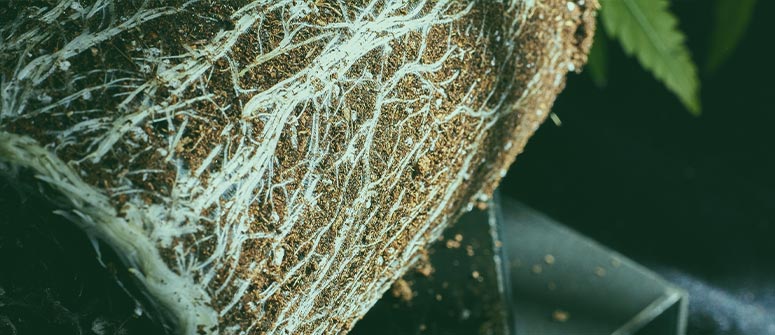
Option 2: Pruning by hand
Manually pruning cannabis roots is much more hands-on and requires more care to perform properly. Nonetheless, it's a great way to encourage healthy root growth and save root-bound plants. To determine if a plant is root-bound, look out for the following symptoms:
- Pale and yellowing leaves, or leaves with burnt edges or brown spots
- Abnormal or stunted growth
- Overall weakness or wilting
If you suspect a plant is root-bound, you can remove it from its pot to make sure—if the roots have begun to grow along the side of the pot and are tangled among each other, the plant is root-bound and in need of manual pruning. Transplanting into a bigger pot or an air-pruning pot won’t work, as root-bound plants typically won’t develop new roots if they’re not pruned by hand first.
Important considerations
Before diving into the pruning process, there are some important considerations to keep in mind. These include:
- Know when to root prune your weed plants: Pruning during the vegetative stage is ideal, as the plant is actively growing and the roots will regenerate quickly. Pruning during bloom is far from ideal, as it inevitably stresses plants and will affect their yield considerably.
- Use clean, sharp pruning scissors or shears: Sterilise all of your equipment before pruning. Remember to avoid handling your plant’s roots directly as much as possible, and make clean cuts to avoid causing damage to the roots.
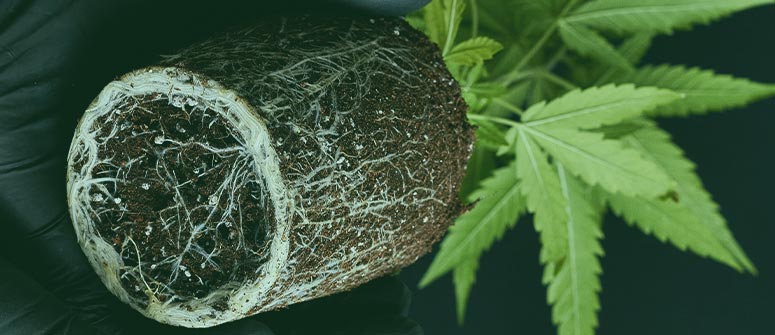
What do you need to root prune cannabis?
- Sharp, clean pruning scissors/shears
- Bucket of cool, pH-neutral water to rinse the roots
- Clean, large work surface
- Gardening gloves
How to: Root pruning cannabis in soil
- Start by removing the plant from its pot and gently shaking off any loose soil. Use your fingers to pinch away any damaged or dead roots (dead roots look brown and dry). Rinse the roots to remove excess dirt (and make steps 2 & 3 easier).
- Identify knots in the plant's root system. These are areas in which a plant's roots have started to grow together and become tangled. Use your trimming scissors to cut open and untangle sections of the roots.
- Trim away the tips of old roots to encourage new growth. Be sure to leave as much healthy root mass as possible, though this will depend on how root-bound a plant has become.
- Once you’re finished pruning, rinse the plant's roots again and replant it (ideally in a larger container). If you’re replanting in the same soil, use a rake or shovel to break apart the soil if necessary. This will also encourage better root growth.
Root pruning cannabis in a hydro system
- Remove the plant you want to root prune from your hydro system.
- Rinse the plant’s roots in water. Start by removing any dead or unhealthy-looking roots first, either by hand or with scissors/shears.
- Use your scissors to cut away any larger knots or tangles of roots, as well as the tips of old roots, to encourage healthy root growth. Remember to leave as much healthy root mass as possible.
- When you’re finished, return the cannabis plant to your hydro system and refill your reservoir.
- Note: If you plan to root prune all of your hydro plants, consider taking the time to drain your reservoir and give the entire system a deep clean to avoid problems with pathogens.
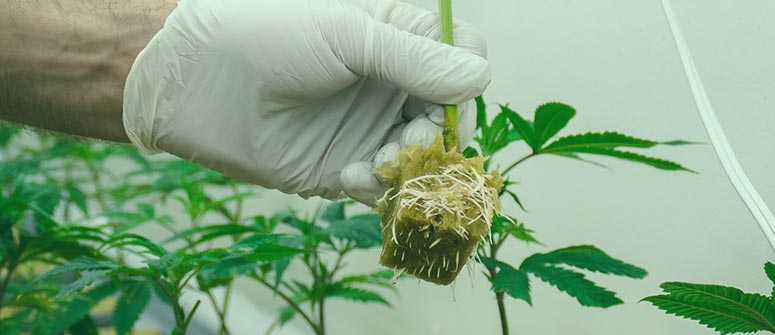
Caring for your plants post-pruning
After having their roots pruned, your cannabis plants will need some time to recover. During this time, be careful not to overfeed or overwater them (remember that their smaller root systems will not take up much water and nutrients). Consider using rooting hormones or beneficial fungi like Trichoderma and mycorrhiza to help promote faster regenerative root growth.
Note: Trimmed cannabis roots make an excellent soil amendment, helping to keep soil light and aerated, as well as contributing organic ingredients to feed soil microorganisms. Alternatively, you can add trimmed roots to your compost.
Keep your cannabis healthy with root pruning
Root pruning is a valuable skill for any cannabis grower. By understanding the process and its benefits, growers can maintain healthy and thriving cannabis plants. Remember to be gentle when pruning the roots, and to avoid overfeeding the plant during the recovery period. With these tips and a little care, you can keep your cannabis plants healthy and thriving.
Root pruning cannabis: FAQ
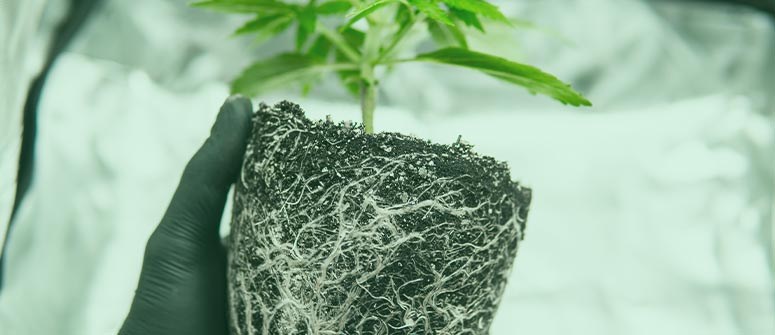
Q: What is root pruning?
A: Root pruning involves trimming away a plant’s old and tangled roots to treat root-bound plants and encourage new, healthy root development.
Q: How do you do root pruning?
A: To properly prune a plant’s roots by hand, it's important to use clean scissors or pruning shears to cut away old, dead, or tangled roots.
Q: What time of year is best to root prune?
A: While most gardeners typically root prune plants in autumn, cannabis is a little different since it grows over the summer. Ideally, outdoor plants should be root pruned in spring or early summer while they are still in the vegetative phase.
Q: What can you do with pruned cannabis roots?
A: Pruned cannabis roots make an excellent soil amendment, helping to keep the substrate well-aerated and providing organic nutrients for soil microorganisms. Alternatively, cannabis roots can be composted.




